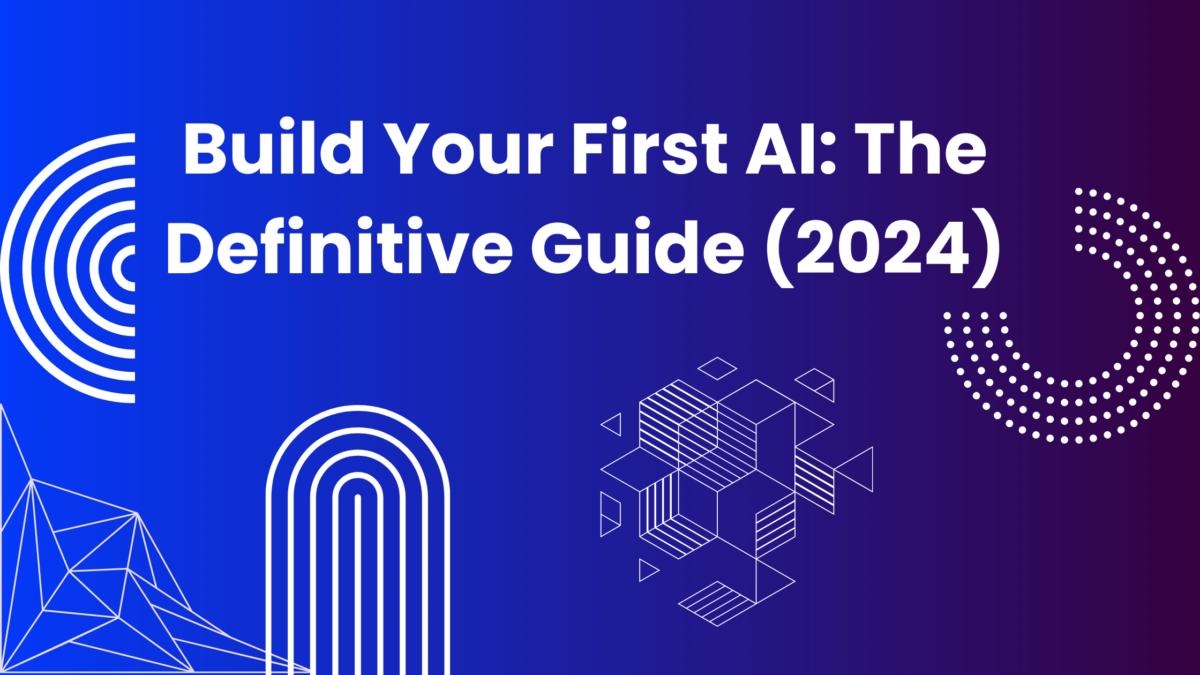This is the definitive guide to building an Artificial Intelligence (AI) system fast and securely in 2025.
So if you want to:
- Build your first intelligent tool
- Master the fundamentals of Machine Learning
- Bring your AI idea to life
Then you’ve come to the right place.
Let’s dive into the exciting world of AI development!
1. Define Your AI’s Purpose: The Heart of Your Intelligent Creation
The very first step to building an AI is identifying its purpose.
This forms the foundation upon which your entire system will be built. What problem are you trying to solve, or what task do you want your AI to automate?
Finding Your Niche:
Think broadly! AI can be applied to countless situations. Here are some examples to spark your creativity:
- Image Recognition Software: Can your AI identify objects or scenes in photographs or videos?
- Stock Price Prediction Model: Can you create an AI that analyzes financial data to predict market trends?
- Chatbot: Can you design an AI-powered chatbot to answer customer questions or provide support?
Beyond the Obvious:
Don’t limit yourself to traditional applications. Consider niche areas where your AI could bring unique value.
- Personalized Learning Assistant: Can your AI tailor educational experiences to individual students?
- Music Genre Classification: Can your AI automatically categorize music based on style or mood?
- Fraud Detection System: Can you build an AI to identify suspicious activity in real time?
Remember: The clearer your purpose, the more focused your development process will be.
Next Steps:
Once you’ve identified your AI’s purpose, jot down specific goals and desired outcomes. This initial clarity will guide you as you delve into the technical aspects of building your AI.
2. Grasp the Foundational Concepts: Machine Learning (ML) 101
Machine Learning (ML) is the core principle powering intelligent systems. It allows AI to learn from data without explicit programming.
Imagine teaching a child by showing them examples, not step-by-step instructions. That’s the essence of ML!
Meet the ML Subfields:
ML has different approaches for different tasks. Let’s explore the big three:
- Supervised Learning: Think of a helpful teacher. In supervised learning, the AI is trained with labeled data, where each data point has a pre-defined outcome. The AI learns the relationship between inputs and outputs, allowing it to make predictions on new, unseen data.
- Unsupervised Learning: This is like exploring a new world on your own. Unsupervised learning deals with unlabeled data, where the AI identifies patterns and relationships within the data itself. This can be useful for tasks like image clustering or anomaly detection.
- Reinforcement Learning: Here, the AI interacts with an environment and learns through trial and error. Imagine training a dog with treats. The AI receives rewards for desired actions, helping it refine its behavior over time. This is often used in robotics and game-playing AI.
Ready to Dive Deeper?
Fortunately, there are fantastic resources available! Online courses on platforms like Udemy or Coursera can equip you with the practical skills you need to master these ML subfields.
Partner with Ihulabs today and embark on a journey toward efficient, robust AI development while fostering an engaged and retained team of developers.
Let’s embark on this AI adventure together! 🤝
3. Choose Your Tools: Building Your AI Arsenal
Now that you’re fired up about developing your AI, it’s time to pick up the right tools. Think of them as your personal AI development workbench.
The Mighty Python:
First up, select a programming language. Python is widely used in AI for its readability and extensive libraries. Think of it as the lingua franca of the AI world.
Deep Learning Frameworks:
Next, explore deep learning frameworks. These are specialized toolkits that handle the heavy lifting of training complex AI models.
TensorFlow and PyTorch are industry leaders, offering powerful features and vast communities for support.
Data Wranglers:
Don’t forget the data wranglers! Libraries like NumPy, Pandas, and Matplotlib are essential for manipulating and visualizing your data.
These are your go-to tools for getting your data squeaky clean and ready for training.
Choosing the Right Tool for the Job:
The best tools depend on your project’s specific needs. Research and experiment to find the perfect fit. Remember, a well-equipped workbench is key to building a successful AI!
4. Data Acquisition is Key: Fueling Your AI’s Intelligence
Your AI is only as intelligent as the data it’s trained on. Here’s how to gather the best fuel for your creation:
- Relevance is King: Identify data directly related to your AI’s purpose. An image recognition AI needs labeled images, not stock prices.
- Cleanliness Matters: Ensure your data is free of errors and inconsistencies. Dirty data leads to inaccurate and unreliable AI models.
- Labeling Makes a Difference: If your AI requires understanding specific elements (e.g., objects in images), ensure your data is properly labeled.
- Quantity is Crucial: There’s no such thing as too much data for training a robust AI. Aim for a large and diverse dataset.
- Ethics First: Always consider responsible data collection practices. Respect user privacy and avoid biases in your data sources.
Action Steps:
- Research data marketplaces offering relevant datasets for your AI’s purpose.
- Consider crowdsourcing data labeling tasks through micro-tasking platforms.
- Explore data augmentation techniques to artificially expand your dataset size.
- Partner with organizations that possess relevant data and share your AI’s goals.
5. Model Selection and Training to Build your AI
Now that you’ve assembled your training data, it’s time to choose the right tool for the job – the Machine Learning (ML) algorithm.
Imagine it as the engine powering your AI. Different algorithms excel at specific tasks.
For instance, decision trees are fantastic for classification problems, while recurrent neural networks are ideal for handling sequential data like text or time series.
Once you’ve selected your champion algorithm, it’s feeding time! Carefully prepared data is fed into the model, allowing it to learn and identify patterns.
This process, called training, is where the magic happens. Think of it as the AI going to school, soaking up knowledge from your data.
But training isn’t a passive process. Monitor its progress closely, fine-tuning hyperparameters – these are settings that influence the learning process.
Imagine them as dials you can adjust for optimal performance. By tweaking these parameters, you can significantly improve your AI’s accuracy and effectiveness.
6. Evaluation and Refinement: Polishing Your AI for Real-World Success
Training isn’t the finish line. Now, we’ll fine-tune your AI for peak performance.
The Test Kitchen: Unveiling Weaknesses
- Challenge your AI with unseen data: Don’t use the same data it trained on. This exposes how well it generalizes to new situations.
Analyze Errors: Spotting the Cracks in the Armor
- Dive deep into errors: Identify patterns in mistakes to pinpoint areas for improvement.
- Ask “Why?”: Understand the root cause of errors to address them effectively.
Refining Your Masterpiece: Techniques for AI Enhancement
- Regularization: Prevent overfitting by controlling model complexity, and reducing sensitivity to training data quirks.
- Data Augmentation: Expand your training data by creating new variations (e.g., rotating images) to improve generalizability.
- Hyperparameter Tuning: Fine-tune settings that influence your model’s learning process for optimal performance.
Remember: Evaluation is an iterative process. Continuously test, analyze, and refine for an AI that excels in the real world!
7. Deployment and Beyond: Unleashing Your AI’s Potential
Your AI has learned and grown, ready to tackle real-world challenges. Now comes the exciting step of deployment!
Going Live: Where will your AI shine?
- Identify the ideal environment: Consider web services for wider reach or mobile apps for on-the-go functionality.
- Package your AI: Convert your model into a format compatible with your chosen platform (e.g., TensorFlow Serving for web services).
Monitoring Performance: Keeping Your AI Sharp
- Track key metrics: Monitor accuracy, response times, and resource usage to identify areas for improvement.
- Embrace continuous learning: Schedule retraining with fresh data to keep your AI adapting to changing environments.
Optimization is Key: Fine-Tuning for Peak Performance
- Analyze errors: Identify patterns in errors to pinpoint weaknesses in your AI’s decision-making process.
- Refine your model: Leverage techniques like hyperparameter tuning or data augmentation for continued optimization.
The Future Beckons: Your AI’s Evolutionary Journey
Deployment is just the beginning! As your AI encounters real-world data, it will continuously learn and evolve. Stay ahead of the curve by:
- Gathering user feedback: Actively solicit user feedback to understand how your AI can better serve their needs.
- Embrace new techniques: Continuously explore advancements in AI research to incorporate the latest developments.
Remember, AI development is an iterative process. By closely monitoring and refining your AI, you’ll ensure it delivers maximum value for years to come.
8. The Thriving AI Community: Your Gateway to Growth
Building an AI isn’t a solitary pursuit. Joining the vibrant AI community unlocks a treasure trove of benefits.
Connect with Fellow Developers:
Online forums and communities bring you together with passionate AI developers.
Share experiences, troubleshoot challenges, and forge lasting connections.
Learn from Shared Expertise:
The community is a wealth of knowledge. Gain insights from seasoned developers, discover best practices, and stay ahead of the curve.
Embrace Continuous Learning:
AI is a rapidly evolving field. The community keeps you informed of the latest advancements, ensuring your skills stay sharp and relevant.
Note: The AI development journey is an ongoing adventure. Embrace the challenges, celebrate breakthroughs, and never stop learning.
With the power of the AI community by your side, you’ll be well-equipped to navigate the exciting terrain of AI development!
Partner with Ihulabs for Cutting-Edge Solutions
Ihulabs is your one-stop shop for bringing the power of AI to life.
Our team of AI development experts possesses the knowledge and experience to craft intelligent solutions tailored to your unique business needs.
Here’s what Ihulabs offers:
- End-to-End AI Project Management: From concept to deployment, we guide you through every stage of the AI development process.
- Custom AI Model Development: Our skilled engineers design and train AI models specifically for your business goals.
- Data Science Expertise: We leverage our data science prowess to ensure your AI initiatives are fueled by high-quality data.
- Real-World Business Impact: We translate complex AI concepts into practical solutions that generate measurable results.
Ready to harness the potential of AI?
Contact Ihulabs today for a free consultation. Let’s discuss how AI can revolutionize your business operations and propel you towards success.
Conclusion: Your AI Development Journey Begins Now
There you have it: The definitive guide to building an AI system.
Now I’d like to hear from you!
Which tip from today’s post are you most eager to try first? Are you planning to build your first intelligent tool, dive deeper into Machine Learning fundamentals, or bring a unique AI idea to life?
Perhaps you’re considering creating a DAO to support your AI development efforts, or maybe you’d prefer to join an existing AI-focused community.
Whatever path you choose, share your thoughts and plans in the comments below! Let’s build the future of AI together.

